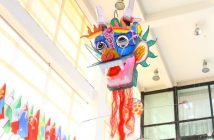Dali
 This town in central Yunnan combines natural beauty with exotic local flavor. Dali has a striking physical location and an interesting history as a former capital. The Bai people have inhabited the area for thousands of years, and their cultural influence is immediately evident in the food and romantic legends of the region.
This town in central Yunnan combines natural beauty with exotic local flavor. Dali has a striking physical location and an interesting history as a former capital. The Bai people have inhabited the area for thousands of years, and their cultural influence is immediately evident in the food and romantic legends of the region.
If your family is feeling adventurous, renting bikes is a great way to explore the area and avoid the tour buses. Since the town is small, it’s no hard task to navigate its thin, cobblestone roads and ancient walls. Its small-town charm has attracted a fair-sized foreign community, which means that decent Western cuisine such as pizza, coffee and pancakes can easily be found. History aficionados will find the Dali museum and its three main pagodas particularly interesting, while hikers can explore Mt. Cangshan – an exquisite mountain famous for strange cloud formations. The nearby Erhai Lake, one of the seven largest lakes in China, is surrounded by tiny villages.
Minorities Rule: Visit the Bai and Yi villages, where families can walk through rice fields, lunch on boats, relax in a local courtyard, browse local markets or enjoy a ride on a horse-drawn carriage.
What to Buy: Minority clothing is a specialty, along with marble, jewelry and tablecloths – all at great prices. Try some traditional Bai snacks and treats on Foreigner Street.
Where to Stay: Jim’s Tibetan Hotel in the old town is a good choice for families. It’s decorated in the Tibetan style and has great Western breakfasts (0872 267 7824, www.jims-tibetan-hotel.com). For a guided tour, try China Minority Travel (www.china-travel.nl).
Where to Snack: Findaaing a small cafe isn’t difficult, but Sweet Tooth on Boai Lu is a favorite among the local expats. One bite of a chocolate chip cookie from this quaint shop will make you forget you’re in China. The cafe also supports the local deaf community.
Travel Tips: Having a local guide is priceless because you get the chance to see how people really live – looking inside their houses, viewing schools and local places that you would never find by yourself.
Getting there: Four-hour flight from Beijing to Kunming, then catch a flight or a 3-hour bus ride to Dali.
Xi’an
 As the ancient capital of 13 Chinese dynasties, Xi’an is a city rich with history – and with numerous tourist attractions, it’s easy to navigate with a family. The thousands-strong Terracotta Army is a sight sure to enthrall adults and children alike (the largest pit holds around 6,000 warriors and horses). The city also boasts early imperial tombs, a thriving Muslim Quarter and a nearby Neolithic village, in addition to the majestic cliffs of Huashan Mountain.
As the ancient capital of 13 Chinese dynasties, Xi’an is a city rich with history – and with numerous tourist attractions, it’s easy to navigate with a family. The thousands-strong Terracotta Army is a sight sure to enthrall adults and children alike (the largest pit holds around 6,000 warriors and horses). The city also boasts early imperial tombs, a thriving Muslim Quarter and a nearby Neolithic village, in addition to the majestic cliffs of Huashan Mountain.
Where to Stay: The four-star Bell Tower Hotel (29 8760 0000, www.belltowerhtl.com) is highly recommended. Request a room that overlooks the Bell Tower – the exact geographical center of Xi’an. Markets, shops, the fascinating Muslim quarter and the ancient city walls are all within walking distance.
What to Eat: Loud and bustling Huimin Jie in the Muslim quarter behind the Drum Tower is packed with restaurants and stalls serving local specialties like lamb skewers. There are also child-friendly Western options, such as the ubiquitous McDonald’s, KFC and Pizza Hut.
Off the Wall: Families can take part in a bike tour around the City Wall (29 8208 2218, www.xa-cq.com). The ride is nice and flat and takes about an hour, though it can get hot and dusty.
Best Splurge: If traveling by train, deluxe-class sleepers are great. The upgraded seats feature a spotless Western-style toilet and washbasin ensuite, a comfy easy chair and an adjustable climate and sound system. The buffet car can get smoky, however, so families should stock up on provisions before boarding the train.
Getting There: One hour and 40 minute flight from Beijing.
Chishui
 Almost a thousand years ago, Chishui was a strategic port city involved in the lucrative salt trade. Although located in Guizhou, this river town is closer to Sichuan province historically, culturally, geographically and economically. Get your bearings with a stroll around the city, being sure to take in the riverside along Hebin Lu. You can head straight to Sichuan by crossing the river or take the kids to enjoy the rare exhilaration of being in two provinces at the same time, with a foot on either side at the middle of the bridge.
Almost a thousand years ago, Chishui was a strategic port city involved in the lucrative salt trade. Although located in Guizhou, this river town is closer to Sichuan province historically, culturally, geographically and economically. Get your bearings with a stroll around the city, being sure to take in the riverside along Hebin Lu. You can head straight to Sichuan by crossing the river or take the kids to enjoy the rare exhilaration of being in two provinces at the same time, with a foot on either side at the middle of the bridge.
The Communists’ legendary Long March also involved a notable adventure around this river. In an attempt to shake off the pursuing Guomindang, the Communists crossed and re-crossed the Chishui river a total of four times as they battled hither and thither. History buffs can re-trace Mao’s footsteps, commemorated at each of the four fording spots, scattered around the region.
Where to Stay: The nicest option in Chishui city is Zhongyue Hotel (中悦大酒店), a clean and comfortable four-star stalwart (0852 282 3888/5999). Mid-range options are abundant, though quality varies. For a rural experience, check out Chishui Electric Power Hotel (赤水电力宾馆), situated near some of the region’s most famous scenic areas and within walking distance of Yanziyan National Park and Shizhangdong Waterfalls. It features villa-style lodgings and a riverside terrace (0852 299 5555).
What to Eat: Chishui restaurants specialize in many delicious bamboo dishes, including fresh bamboo shoots stir-fried with bacon (zhusun chao la rou), stewed dried bamboo (tongtong zhu), and a "Panda Feast" (xiongmao yan) – a bamboo-themed banquet perfect for larger parties.
Parks Galore: Chishui has lush forests due to abundant rainfalls and has a rich array of parks. The noble sala tree (桫椤), which dates back to the time of the dinosaurs, is particularly numerous in the Shaluo National Preservation Area (赤水桫椤国家级自然保护区. RMB 25). Nearby is Chishui’s Bamboo Ocean (竹海, RMB 25), a protected forest where mighty stalks of nanzhu (楠竹), one of the world’s thickest and tallest bamboo species, nod and sway in the breeze as far as the eye can see in every direction. (The parks mentioned above are free for children under 1.3 meters tall and half-price for students with valid ID. Aside from Shizhangdong, which is open only in the morning, all parks are open from dawn to dusk.)
Site to Remember: Wuzhufeng (五柱峰, RMB 80) deserves a whole day of exploration. The curious red rocks (danxia 丹霞) here are officially recognized as a UNESCO World Heritage Site. The highlight of this sublime assortment of geological formations may be an enormous, breathtaking arc of red rock wall (佛光岩丹霞绝壁) – a natural amphitheater lightly tickled by a waterfall.
Getting There: Three-hour flight from Beijing to Luzhou, then a 2-hour drive to Chishui.
Don’t forget to check out Part 1 of this post.



